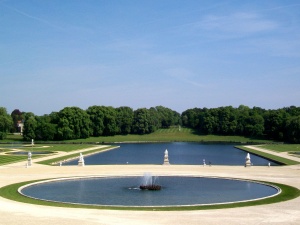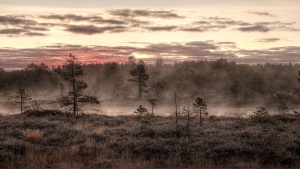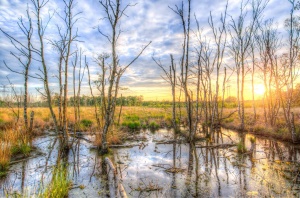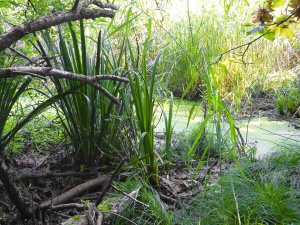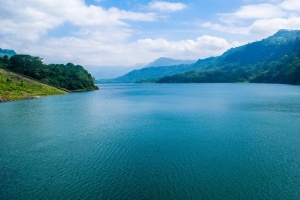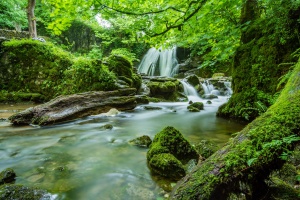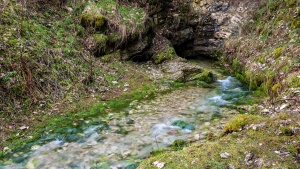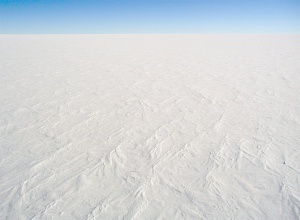A pond is an area filled with water, either natural or artificial, that is smaller than a lake. Ponds may arise naturally in floodplains as part of a river system or can simply be an isolated depression (such as a kettle, vernal pool, or prairie pothole) that filled with runoff, groundwater, or precipitation. As such, ponds may be freshwater, saltwater, or brackish in nature.
Many ponds contain shallow water ecosystems, often termed pond life, with varying abundances of aquatic plants and animals. Certain characteristic such as depth, seasonal water level, nutrients fluxes, solar radiation, degree of inlets and outlets, local organisms, and salinity may affect the types of ecosystems present within a pond.
Ponds are frequently man-made or expanded beyond their original depths and bounds by anthropogenic causes. Among their many uses, ponds provide water for agriculture, livestock and communities, aid in habitat restoration, serve as breeding grounds for local and migrating species, are components of landscape architecture, flood control, general urbanization, mitigate particular pollutions and greenhouse gasses, and support wide varieties of organismal ecosystems.
Pond Biodiversity
A defining feature of a pond is the presence of standing water which provides habitat for a biological community commonly referred to as pond life. Because of this, many ponds and lakes contain large numbers of endemic species that have gone through adaptive radiation to become specialized to their preferred habitat. Familiar examples might include water lilies and other aquatic plants, frogs, turtles, and fish.
Common freshwater fish species include the Large Mouth and Small Mouth Bass, Catfish, Bluegill, and Sunfish such as the Pumpkinseed Sunfish shown above
Often, the entire margin of the pond is fringed by wetland, and these wetlands support the aquatic food web, provide shelter for wildlife, and stabilize the shore of the pond. This margin is also known as the littoral zone and contains much of the photosynthetic algae and plants of this ecosystem called macrophytes. Other photosynthetic organisms such as phytoplankton (suspended algae) and periphytons (organisms including cyanobacteria, detritus, and other microbes) thrive here and stand as the primary producers of pond food webs. Some grazing animals like geese and muskrats consume the wetland plants directly as a source of food. In many other cases, pond plants will decay in the water. Many invertebrates and herbivorous zooplankton then feed on the decaying plants, and these lower trophic level organisms provide food for wetland species including fish, dragonflies, and herons both in the littoral zone and the limnetic zone. The open water limnetic zone may allow algae to grow as sunlight still penetrates here. These algae may support yet another food web that includes aquatic insects and other small fish species. A pond, therefore, may have combinations of three different food webs, one based on larger plants, one based upon decayed plants, and one based upon algae and their specific upper trophic level consumers and predators. Hence, ponds often have many different animal species using the wide array of food sources though biotic interaction. They, therefore, provide an important source of biological diversity in landscapes.
Opposite to long standing ponds are vernal ponds. These ponds dry up for part of the year and are so called because they are typically at their peak depth in the spring (the meaning of "vernal" comes form the Latin word for spring). Naturally occurring vernal ponds do not usually have fish, a major higher tropic level consumer, as these ponds frequently dry up. The absence of fish is a very important characteristic of these ponds since it prevents long chained biotic interactions from establishing. Ponds without these competitive predation pressures provides breeding locations and safe havens for endangered or migrating species. Hence, introducing fish to a pond can have seriously detrimental consequences. In some parts of the world, such as California, the vernal ponds have rare and endangered plant species. On the coastal plain, they provide habitat for endangered frogs such as the Mississippi Gopher Frog.
Source: Wikipedia contributors. "Pond." Wikipedia, The Free Encyclopedia. Wikipedia, The Free Encyclopedia, 27 Jun. 2021. Web. 28 Jun. 2021.


